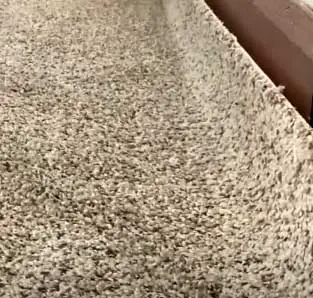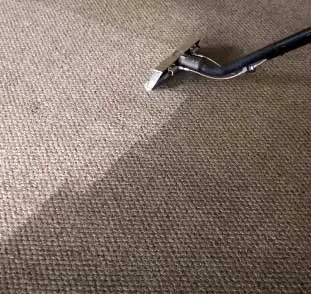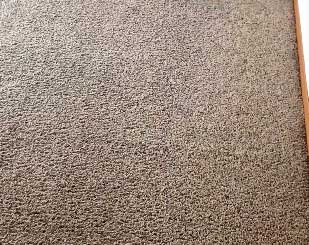When shopping for new carpeting, one of the first decisions you’ll make is whether to go with berber or regular carpet. These two popular options have distinct pros and cons to consider based on factors like appearance, durability, comfort, cost, and more.
This guide will compare berber and regular carpeting to help you determine the best choice for your home.
Key Differences At A Glance
| Factor | Berber Carpet | Regular Carpet |
| Fibers | Usually small dense wool loops | Various fibers including nylon, polyester, etc. |
| Pile Height | Low (3/8” or less) | Varies from low to high pile |
| Texture | Matte, smooth | Range from plush to textured saxony |
| Durability | Very durable | Depends on fiber and construction quality |
| Comfort | Firm support | Plusher feeling underfoot |
| Stains | Excellent resistance | Variable resistance |
| Cost | $2-6 per sq.ft. installed | $1-20+ per sq.ft. installed |
| Use | High traffic areas | Variable depending on quality |
Now let’s explore some of these factors in more depth.
Berber Carpet Overview

Berber carpeting is a specific style of loop pile carpet, not a fiber type itself. It’s made up of tightly packed uncut loops of wool or synthetic fibers like nylon or olefin (polypropylene). The rows of loops give it a nubby, textured look.
Traditional berber carpets use 100% wool loop piles in neutral earth tone colors. But today you can find berber made from various synthetic fibers and available in a rainbow of color options. What defines them as berber is the short, dense looped construction.
Other defining features include:
- Low packed pile height, usually 3/8” or less
- Matte, smooth texture with visible loop pattern
- Excellent durability and stain/soil resistance
- Firm support and comfort underfoot
- Affordable compared to other wool carpets
Berbers work well in high traffic areas of homes and public spaces. The resilient wool and looped construction stands up well to frequent footsteps. Areas like hallways, family rooms, dens, bedrooms, and basements are all suited to berber’s practical qualities.
Regular Carpet Overview

What we call “regular carpet” encompasses all carpeting outside of distinct styles like berber.
Regular carpets use a wide variety of construction types, fiber blends, pile heights, textures, and colors.
Anything from basic polyester cut pile builder-grades to sumptuous wool saxonies falls into the broad category.
Like berbers, regular carpet fiber options include natural and synthetic varieties:
- Common synthetic fibers: nylon, polyester, triexta/SmartStrand, olefin/polypropylene
- Common natural fibers: wool, cotton, sisal
Beyond fiber content, factors like pile type, density, height, twist, dye method, backing, and more influence the carpet’s performance and feel. Regular carpets span these features, offering consumers far more versatility.
You’ll find regular carpet everywhere from inexpensive apartment rentals to luxury estates. Fiber and construction quality varies widely, as do price points. But with so many choices, it’s easier to match specific room requirements.
Comparing Durability
How well a carpet withstands daily use over time depends primarily on two factors – fiber type and construction quality.
- Berber carpets shine for durability thanks to wool’s inherent strength and resilience. The tightly packed loop pile also protects the yarn structure from crushing and matting. Heavy household traffic over 10+ years is no match for a high-end wool berber.
- Regular carpets offer mixed durability depending on quality. Nylon stands as the most durable synthetic. Top brands like Stainmaster Tactesse and Anso Caress rate over 30,000 double rubs on the Wyzenbeek test. Compare that to 5,000 – 15,000 double rubs for most polyester. But cut pile nylon shows crushing, matting, and wear sooner than dense looped berber wool.
Winner: Berbers take the gold for longest-lasting carpets, but premium nylon regular carpets take decent abuse too.
Comparing Appearance
Berbers and regulars showcase very different aesthetics. Choose based on room goals and personal style.

- Berber carpeting impresses with its low-profile, neutral, textural look. Subtly patterned loops resemble chenille fabrics for cozy appeal. Traditional off-white sheep’s wool berbers blend into rustic and farmhouse rooms. Or make a statement with colorful loops popping against dark laminate floor surrounds.
- Regular carpets grab attention with plush to touch textures or all-over patterns. Cut pile types like saxony or frieze offer classic broadloom allure. For variety, tip sheared textures and carved patterns feel both cushy and artful. High-low shags make drama for retro flair. Overall, regular carpets provide unlimited variety.
Winner: Regulars for the win if you like lusher, plushier floors. Go for berber loops if you prefer understated texture.
Comparing Softness and Comfort
Do you prioritize carpet comfort? Plush, springy softness differs drastically between berber and regular carpets.
- Berber carpets don’t aim for pillowy yield. The dense flat loops feel firm underfoot – comfortable but not cushy. Lacking thick cushioning, berbers don’t insulate rooms as well either. But the modest pile height resists crushing to retain support.
- Regular carpets vary widely in luxurious feel. Deep, dense piles insulate rooms better while offering toe-squishing plushness. The super-soft types like saxony use spun yarns for extra fullness. But heavy traffic can permanently matt and crush overly thick regular carpet piles. Finding the right balance means factoring in pile density, height, and fiber quality for the room.
Winner: Regulars better indulge your desire for step-in bliss. Prefer stable support and insulation? Opt for berber loops.
Comparing Costs
Carpet prices run the gamut from budget-friendly berbers to luxurious custom regular installs topping $100/square foot. Setting a realistic budget guides smart comparisons.
- Berber carpets fall on the affordable end for wool broadloom. Expect to spend around $2-6 per square foot installed. Basic polyester or olefin berbers start under $2 per square foot. But lower quality comes with shorter lifespan in high traffic.
- Regular carpets range wildly in price thanks to broad quality diversity. Entry-level polyester cuts start around $1 per square foot. Luxurious wool saxonies reach $4-6 per square foot just for materials. Then specialized weaving, unique fibers like silk or bamboo, intricate patterns, and custom dying add more expense. In total, regular carpet costs range from $1 per square foot on the very low end up to $20+ per square foot installed on the high end.
Winner: Berbers win for budget buyers wanting wool’s perks. Custom shoppers should expect higher investments for premium regulars.
Comparing Stain and Soil Resistance
Life happens. Carpets must cope with spills, pet accidents, mud, and chronic grime. How well do berber and regular styles resist stains?

- Berber carpets hold an advantage for stain protection. Wool berbers naturally resist liquid absorption thanks to wool’s outer cuticle. Treatment with stain protectors boosts performance. Low, tight loop construction also limits penetration by grime compared to high, loose cut piles prone to falling between the cracks.
- Regular carpets offer mixed stain resistance tied to fiber and quality. Nylon stands out as one of the most stain-resistant fibers, especially solution-dyed varieties. However, even heavy duty nylon can suffer stains without after-market treatment. Regular polyester and triexta carpets need frequent professional cleaning to maintain appearance. Wool and wool-blend regular cuts also resist stains fairly well. But no normal carpet stays perfect forever.
Winner: Berbers thanks to densely packed wool and enhanced protection from spills. Certain nylon regulars come close with special stain-treatment though.
Best Carpet Fibers Compared
Beyond pile style, fiber content plays a key role in carpet durability, appearance, and cost. Let’s compare the most common options.
Wool – The luxury option beloved for natural resilience, texture, and comfort. Berber wool impresses for durability while regular wool carpets indulge bare feet thanks to insulation and moisture-wicking. But the high cost limits wool to 30% of total U.S. carpet sales.*
Nylon – Tough, durable, easy to clean, abrasion-resistant, and budget-friendly thanks to wide availability. Nylon dominates commercial spaces and residential applications alike, holding almost 50% of market share.
Polyester – Affordable alternative with decent durability and easy maintenance. Lacks luxury cachet but allows homeowners to carpet more space per dollar. Polyester takes 10% market share.
Triexta (SmartStrand/Sorona) – Relatively new eco-friendly fiber with exceptional stain resistance thanks to PTT polymer chemistry. Durability and softness falls between nylon and polyester. Gaining popularity with 5% of sales and growing.
Olefin (Polypropylene) – Very strong, chemically resistant, abrasion-resistant. Mainly used indoors for berber carpets and outdoors on grass-like turf carpets. Claims almost 5% of total demand.
Specialty fibers like wool and silk blends, bamboo, sea grass, and more fill niche appeal. But the biggest four fibers above meet needs for over 90% of homeowners.
Best Carpet Construction Compared

Beyond fiber content, carpet construction influences quality, feel, and performance.
Cut Pile – The vast majority of residential broadloom features cut pile construction. Long yarn strands get sheared at the ends for soft, plush finish. Most regular carpets use cut pile including saxony, plush, frieze, and more. Durability varies.
Loop Pile – Looped fibers retain integrity better than cut, resisting crushing and extending product lifespans. Commercial spaces favor loop construction but home consumers often find it scratchy. Berbers offer popular residential loop option.
Cut and Loop – Combines cut and loop piles for added visual interest. Creates engaging textures and patterns beyond basic solid cuts. Provides nice balance of durability and plushness.
Other specialized construction choices like woven carpets, hand-knotted orientals, flatweaves, and bonded hybrids serve niche preferences. But most householders choose from cut piles, loops, or cut-and-loop mixes.
Comparing Shedding and Fuzzing
Lint and stray fibers collecting on your dark pants? No carpet stays completely unfuzzy forever with use. But fiber, pile height, and construction influence shedding and fuzzing.
Berber carpets rarely shed noticeably despite looped construction. The dense, low packed loops don’t allow stray ends to work free. Wool loops maintain their structure while synthetic berber fibers resist breakdown.
Regular carpets vary widely in shed and fuzz resistance. Loose, messy piles create headaches especially on stairs. But well-constructed frieze and saxony carpets using quality nylon or wool shed less than bargain shags and plushes.
Winner: Berbers! The uniform loops keep stray fibers firmly in place. Poorly constructed regular cuts loose strands constantly.
Comparing Pet-Friendliness
For pet owners, a smart carpet choice prevents accidents and resists damage from clumsy paws, body oils, and ground-in kibble. How do berber and regular stack up?
- Berber carpets allow simple pet clean-up thanks to fibers that resist absorption. The low packed loops don’t give odors crevices to hide within. Smaller paws don’t get caught in overly tall piles. Neutral berber colors forgive fur blending thanks to mellow variegation.
- Regular carpets pose higher risk of pet damage and stains. Highly absorbent polyesters and delicate construction show effects of accidents immediately in matting and yellow spots. But tightly constructed nylon frieze and olefin berber stand up to pets fairly well. Overall it depends on the specific carpet quality not the general pile category.
Winner: Berbers for pets who might have accidents or enthusiastically run and play indoors. Certain durable, stain-resistant regular cuts work too.
Best Carpet for Bedrooms
Bedrooms demand indulgent softness for cozying up with books or nestling your toes into after a long day. Here plush regular cuts lead over firmer berbers. Frieze and wool or wool-blend saxonies rank among the best carpets for master and guest bedrooms. If choosing berber, pick a soft, springy synthetic like nylon over rougher wool.
Best Carpet for Family Rooms
Family spaces need durable, carefree carpets able to handle heavy foot traffic from kids and adults alike. Tightly constructed wool berbers withstand years of weekly movie nights and game sessions without showing obvious wear. More budget-friendly synthetic berbers work well too. Of regular carpets, frieze rates best for active families.
Best Carpet for Formal Spaces
Formal living spaces and dining rooms need refined carpet styles. Luxurious wool regular cuts feel decadent underfoot while providing an elegant foundation layer. Patterned textures and sophisticated hues polish the aesthetic. Or pick wool-blend berbers in appealing colors like ruby red or ocean blue for low-profile durability.
Best Carpet for Entryways
Low, dense loop piles work wonders in entryways constantly barraged by incoming dirt and footsteps. Here berbers help lock out grime thanks to wool’s or nylon’s inherent stain resistance.
Regular low pile loops also resist soiling fairly well, but may lack berber’s crisp uniform texture. Colorwise, opt for dark shades or variegated mixes to disguise traffic patterns over time in entry spaces.
Best Carpet for Bedrooms
Bedrooms demand indulgent softness for cozying up with books or nestling your toes into after a long day. Here plush regular cuts lead over firmer berbers. Frieze and wool or wool-blend saxonies rank among the best carpets for master and guest bedrooms. If choosing berber, pick a soft, springy synthetic like nylon over rougher wool.
Best Carpet for Stairs and Hallways
Stairs and hallways endure heavy abuse, so steer clear of fancy fringed silk shags! The best stair and hallway carpets feature flatwoven or loop construction and durable, grippy fibers. Tight, resilient wool berbers suit these high traffic zones beautifully.
Level loop or low pile cut styles without too much pile differentiation also work well. Added backing reinforcement helps regular cuts last longer despite constant flexion from feet.
Frequently Asked Questions (FAQ)
Still deciding between berber vs regular carpet? These common questions can help tip your decision.
Yes, berber carpets (especially wool varieties) are generally much more durable than regular carpets. Construction plays a key role here – berber’s dense packed loops resist crushing and shedding over decades of use. Tight looped wool outlasts cut pile synthetics which can matt and deform faster underfoot. Of regular carpets, well-made nylon frieze cuts approach berber’s impressive durability.
No, berbers rank on the budget end of broadloom carpets. While cheap regular polyester or olefin carpet goes for $1/square foot or less, it won’t impress with longevity or comfort. Berbers let homeowners enjoy wool’s benefits starting around $2-3/square foot installed. For softness and artful textures exceeding berber’s abilities, premium regular cuts cost many times more.
The term “berber carpet” stuck even as manufacturing improved over traditional Moroccan techniques. Today’s berber carpets primarily come from modern mechanized commercial looms, not handweavers. Synthetic berbers using nylon and olefin fibers surpass wool in sales. Names like “Cambridge berber” describe predominantly machine-made synthetic wall-to-wall berber carpet. Despite changes, “berber” accurately describes the loops.
It depends on the room, budget, and needs! For a classic broadloom look with wide variety in color, pattern, and texture, regular cut pile saxonies and friezes suit many homes well. To invest in supreme longevity across decades, opt for wool or nylon berber in high traffic zones.
Analyze each room’s traffic, furniture, sun exposure, insulation needs and stain risks. Then pick carpets balancing aesthetics,durability, and maintenance requirements the best. Compromise on priorities helps find your perfect residential carpeting fit.
The Bottom Line
Berber and regular carpets each have advantages. Berbers promise unmatched durability and stain resistance. Regular carpets offer unlimited decorative variety and indulgent softness. Evaluate your priorities for each room, then select versions with construction and fibers to match.
With proper installation and care, both berber and regular carpets provide years of cozy, comfortable performance enhancing your home’s interiors beautifully.
